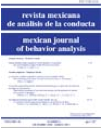Spatial learning and spontaneous recovery in humans
Main Article Content
Abstract
The aim of present study was to demonstrate spontaneous recovery effect in humans using a swimming virtual task analog to Morris pool. Two experiments with a task of spatial learning of swim virtually (VSL Nesplora ©) are presented. In the first experiment the participants learned to locate in 8 trials the exit platform that was located between the points of reference that formed the objects A and B. In Experiment 2, the spatial task of the previous experiment was presented to two groups, but during the first phase the platform was located between objects A and B, whereas during the second one it was located between C and D; both phases consisted of 12 trials. A test was performed with the four objects present and without the platform, a group at 0h and the second one 24h later. The results showed that when the test was made at 0h, platform searching is based on landmarks C and D, but when the test was made at 24h an intermediate choice between landmarks AB and CD was observed. The experimental model presented is contrasted with the studies of spatial learning in animals where associative effects have been observed.
